10 Benefits of Control and Monitoring Systems for Defense Contractors
Discover the essential benefits of control and monitoring systems for defense contractors.

Overview
The article outlines ten significant benefits of control and monitoring systems specifically designed for defense contractors. These systems play a crucial role in enhancing operational efficiency, ensuring compliance with regulations such as CMMC, and bolstering overall security.
Each benefit is substantiated with evidence that illustrates how these systems streamline processes, cut costs, and enhance decision-making capabilities. For instance, organizations that implement these systems often find themselves better positioned for success in a highly regulated environment.
Why should defense contractors consider these systems? The answer lies in their ability to transform operational practices. By adopting control and monitoring systems, contractors can not only meet compliance requirements but also gain a competitive edge in the industry.
In summary, the integration of these systems is not just a regulatory necessity; it’s a strategic move that can lead to improved performance and security. Organizations are encouraged to explore the resources available to them and take action towards implementing these essential systems.
Introduction
Navigating the complex realm of defense contracting can feel overwhelming, particularly with the constantly shifting landscape of compliance and cybersecurity requirements. Control and monitoring systems stand out as vital tools, empowering organizations to boost operational efficiency, adhere to rigorous standards, and safeguard sensitive information.
But here’s the real question: how can defense contractors effectively harness these systems to not only fulfill compliance obligations but also foster innovation and achieve cost savings in a fiercely competitive sector?
This article explores the numerous advantages of implementing robust control and monitoring frameworks, offering insights that could redefine success for military contractors.
CMMC Info Hub: Streamlined Compliance for Defense Contractors
CMMC Info Hub stands as a vital centralized resource, demystifying the intricate landscape of CMMC regulations for military contractors. Are you navigating the complexities of compliance? This platform offers practical strategies and peer insights that transform confusion into clarity, empowering organizations to confidently meet the stringent standards set by the Department of Defense.
With organized guidance, comprehensive roadmaps, and actionable strategies, CMMC Info Hub is indispensable for contractors seeking to secure government contracts while maintaining robust cybersecurity practices. It not only enhances understanding but also significantly improves adherence rates by delivering tailored insights that address the unique challenges faced by security sector contractors.
By effectively utilizing the CMMC Info Hub, organizations can streamline their compliance processes, ensuring they are well-equipped to tackle the intricacies of the requirements. Don't let uncertainty hold you back—leverage this resource to fortify your compliance journey and position your organization for success.
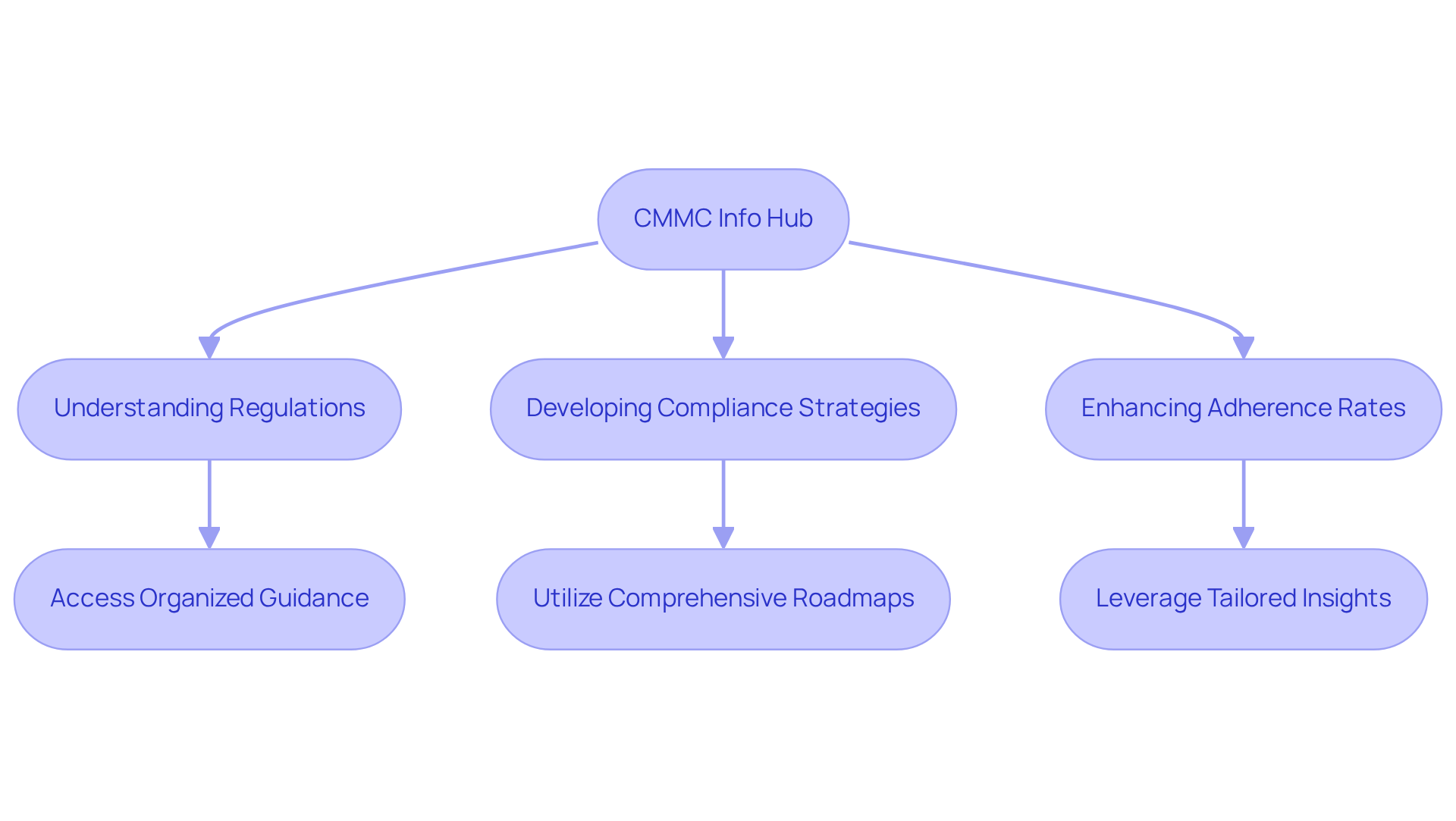
Real-Time Monitoring: Enhance Operational Efficiency
Implementing a control and monitoring system empowers defense contractors to continuously track their operations. This capability allows for the rapid identification of inefficiencies and potential issues. But why is this important? This proactive strategy not only enhances productivity but also plays a crucial role in ensuring adherence to CMMC standards.
By utilizing a control and monitoring system for operational processes, organizations can effectively manage risks and enhance their cybersecurity posture. Ongoing monitoring has been shown to improve visibility into security and compliance, with 71% of users reporting enhanced insights due to automated systems. Furthermore, organizations leveraging automated monitoring tools can reduce compliance program costs by up to 50%, while also achieving faster incident response times. This is essential in the contracting sector, where the stakes are high and robust security measures are critical.
As the landscape of cyber threats evolves, having a control and monitoring system becomes an indispensable component for maintaining operational efficiency and safeguarding sensitive information. Are you ready to take action? Embrace these tools to not only meet compliance requirements but to also fortify your organization against emerging threats.
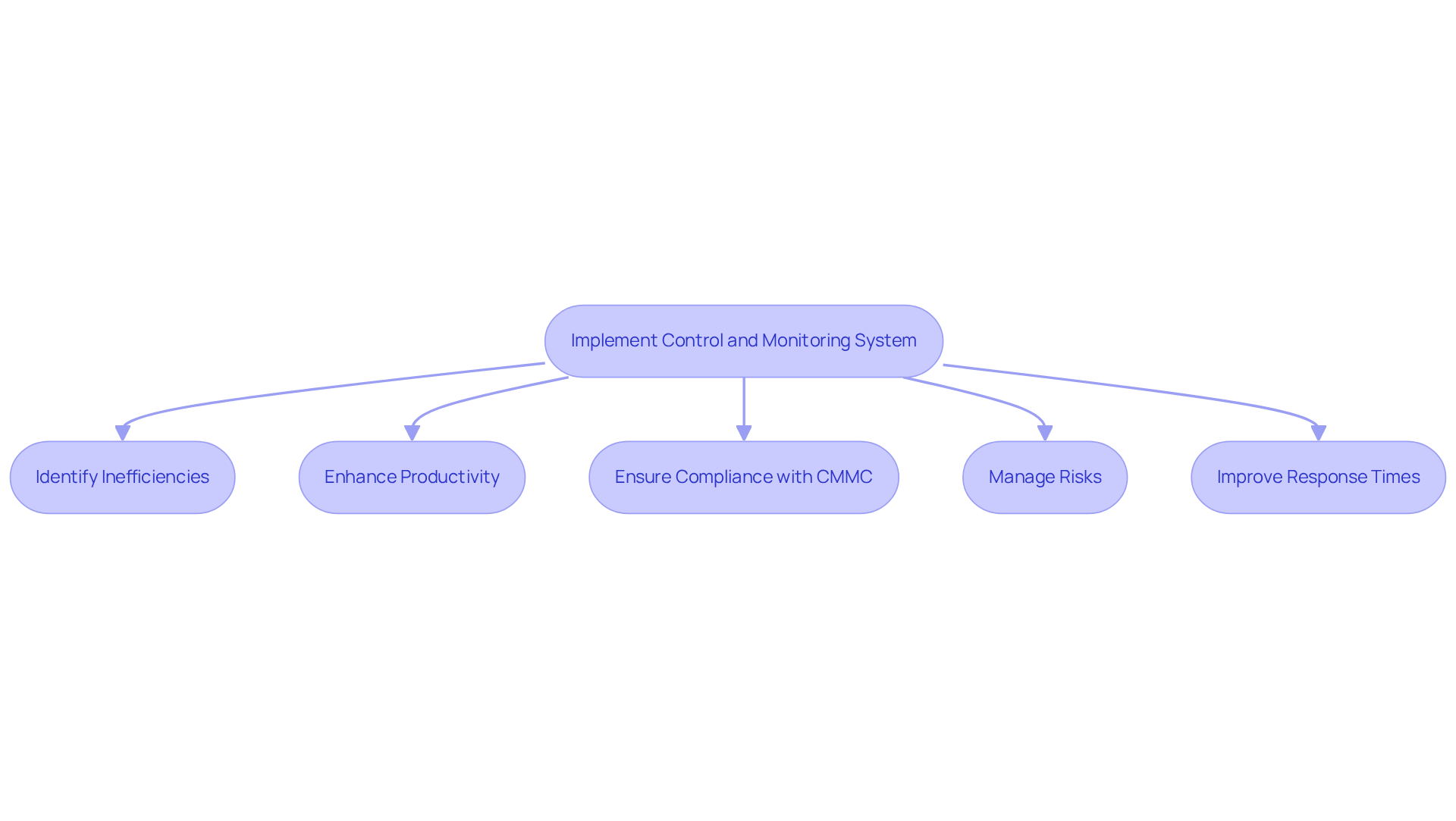
Predictive Maintenance: Minimize Downtime and Extend Equipment Lifespan
The control and monitoring system is essential for predictive maintenance as it analyzes equipment performance data to forecast potential failures. This capability allows contractors to schedule maintenance proactively, which not only decreases unexpected downtime but also prolongs the lifespan of essential equipment.
Ongoing monitoring practices are vital for achieving CMMC standards. Regular vulnerability scanning, prompt patch management, and continuous incident monitoring are essential components of this process. By integrating these practices into their operations, contractors in the security sector can ensure compliance while enhancing operational efficiency.
Consider the impact: how much could your organization save by reducing downtime? By prioritizing these practices within your control and monitoring system, you not only protect your systems and information but also position your organization as a leader in compliance and operational excellence.
In summary, embracing predictive maintenance and ongoing monitoring is not just a best practice; it's a strategic move that safeguards your assets and ensures adherence to industry standards.
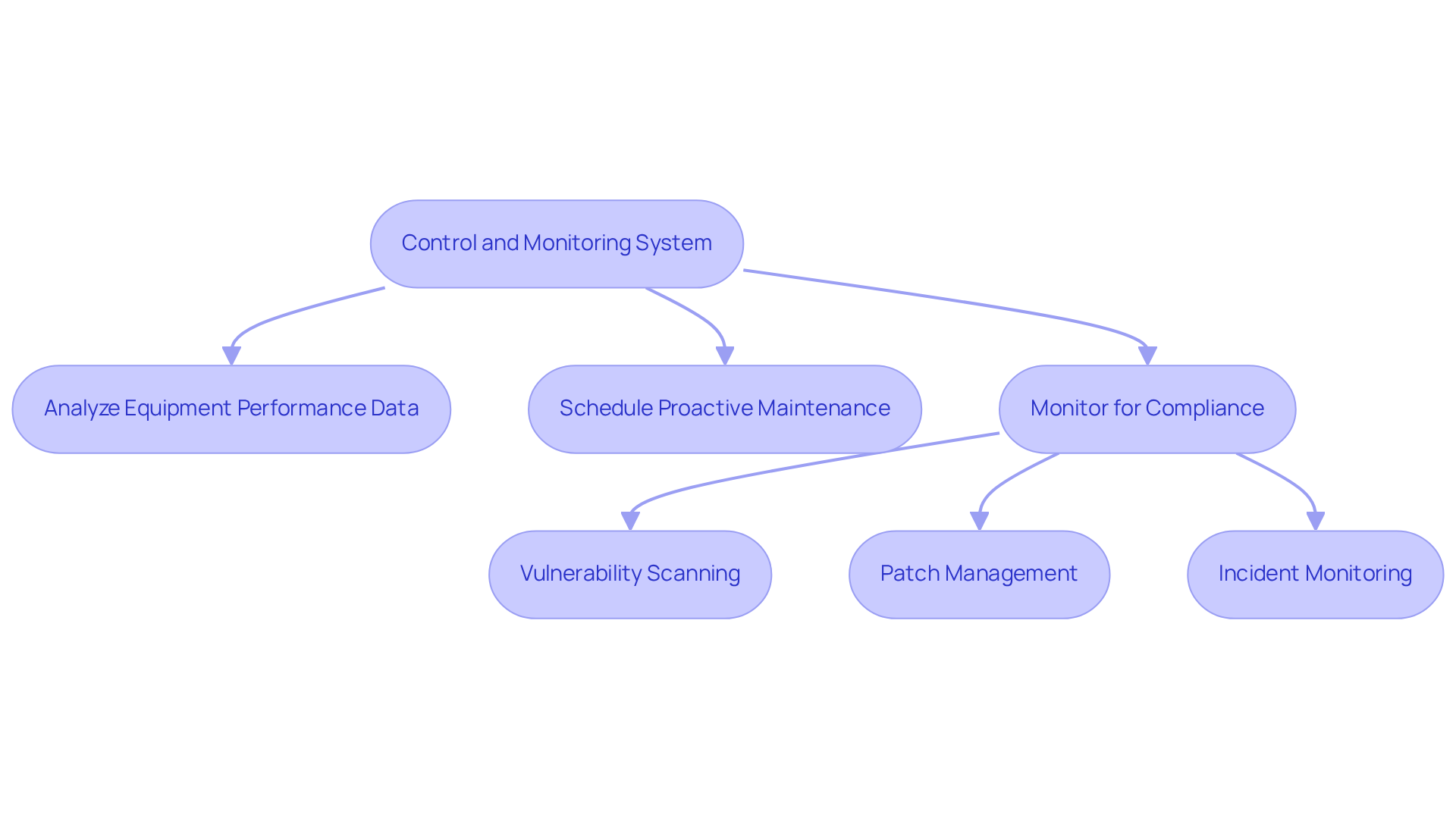
Data Analytics: Informed Decision-Making for Project Success
Data analytics empowers contractors to gain valuable insights into project performance, resource allocation, and risk management. This informed decision-making approach not only drives project success but also seamlessly integrates regulatory measures into operational strategies, turning confusion into clarity. How can clarity and knowledge enhance decision-making? By enabling teams to navigate complexities with confidence.
To achieve CMMC adherence, military contractors should implement effective strategies, including:
- Routine data assessments
- Sharing peer insights
- Fostering a culture of ongoing learning
By embracing data-informed insights and these practical strategies, contractors can enhance operational efficiency and ensure compliance with regulatory standards. This ultimately leads to more successful project implementations. Are you ready to take action and leverage these resources for your projects?
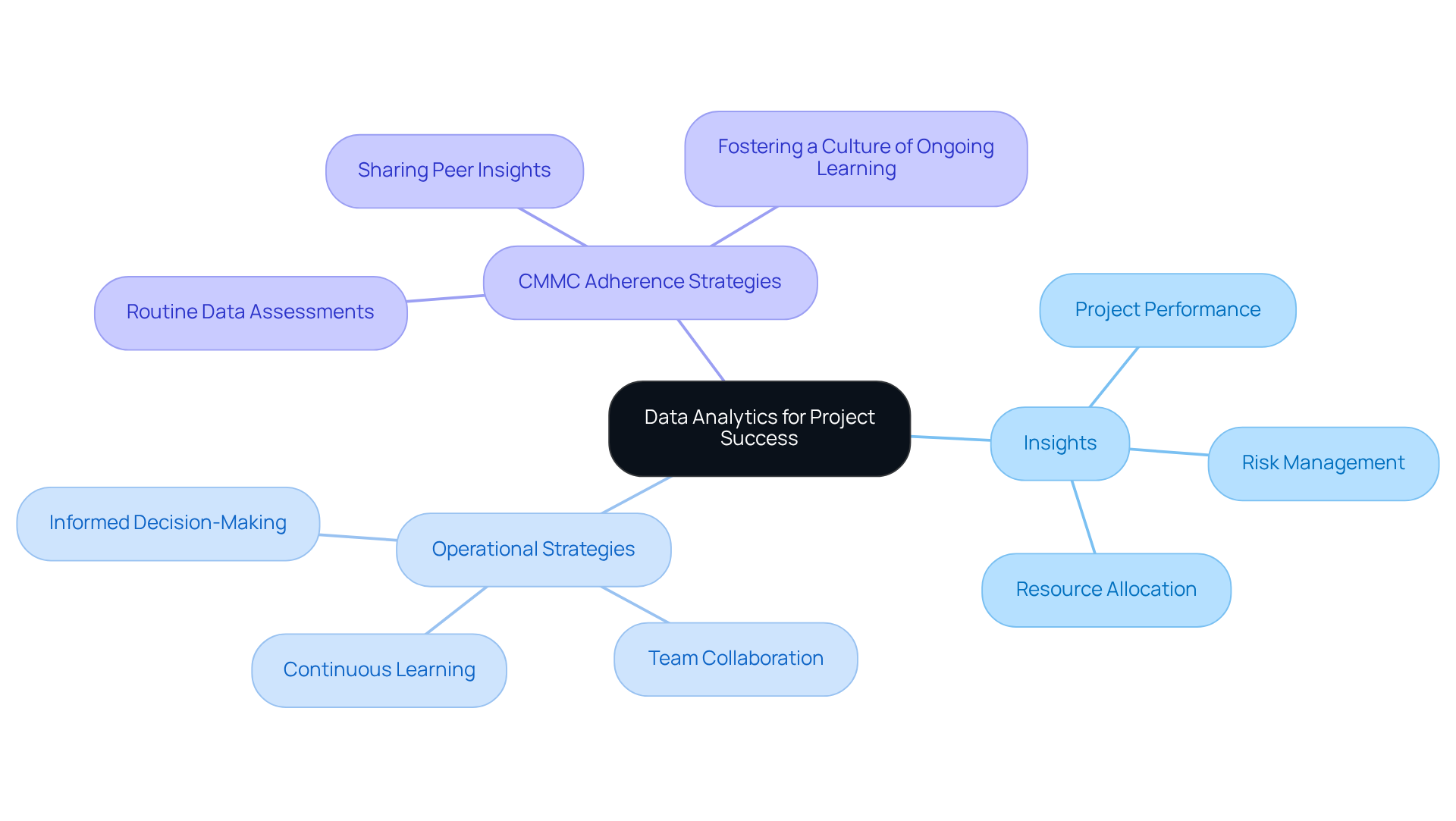
Enhanced Security: Protect Sensitive Information
Control and oversight frameworks are essential for enhancing security in defense contracting. They employ robust mechanisms designed to protect sensitive information, making them vital for identifying irregularities and preventing unauthorized access. This is crucial for maintaining compliance with regulatory requirements. By ensuring that data handling practices align with established cybersecurity standards, these frameworks safeguard critical defense-related information from potential threats.
Moreover, integrating a control and monitoring system with continuous monitoring capabilities enables organizations to respond swiftly to any irregularities, thereby strengthening their overall data security posture. As highlighted in the Ultimate Guide to Achieving Compliance, ongoing practices for a control and monitoring system are indispensable for contractors in the security sector.
As the landscape of defense contracting evolves, establishing effective control mechanisms becomes increasingly important for protecting sensitive information and ensuring compliance. Are you equipped to meet these challenges? CMMC Info Hub serves as your comprehensive resource, providing practical strategies and peer insights to help you achieve CMMC adherence with confidence.
To enhance your compliance efforts, consider:
- Regularly reviewing your control and monitoring system
- Conducting training sessions for staff on security protocols
- Utilizing automated tools for real-time threat detection
Taking these steps not only fortifies your security measures but also positions your organization as a leader in compliance.
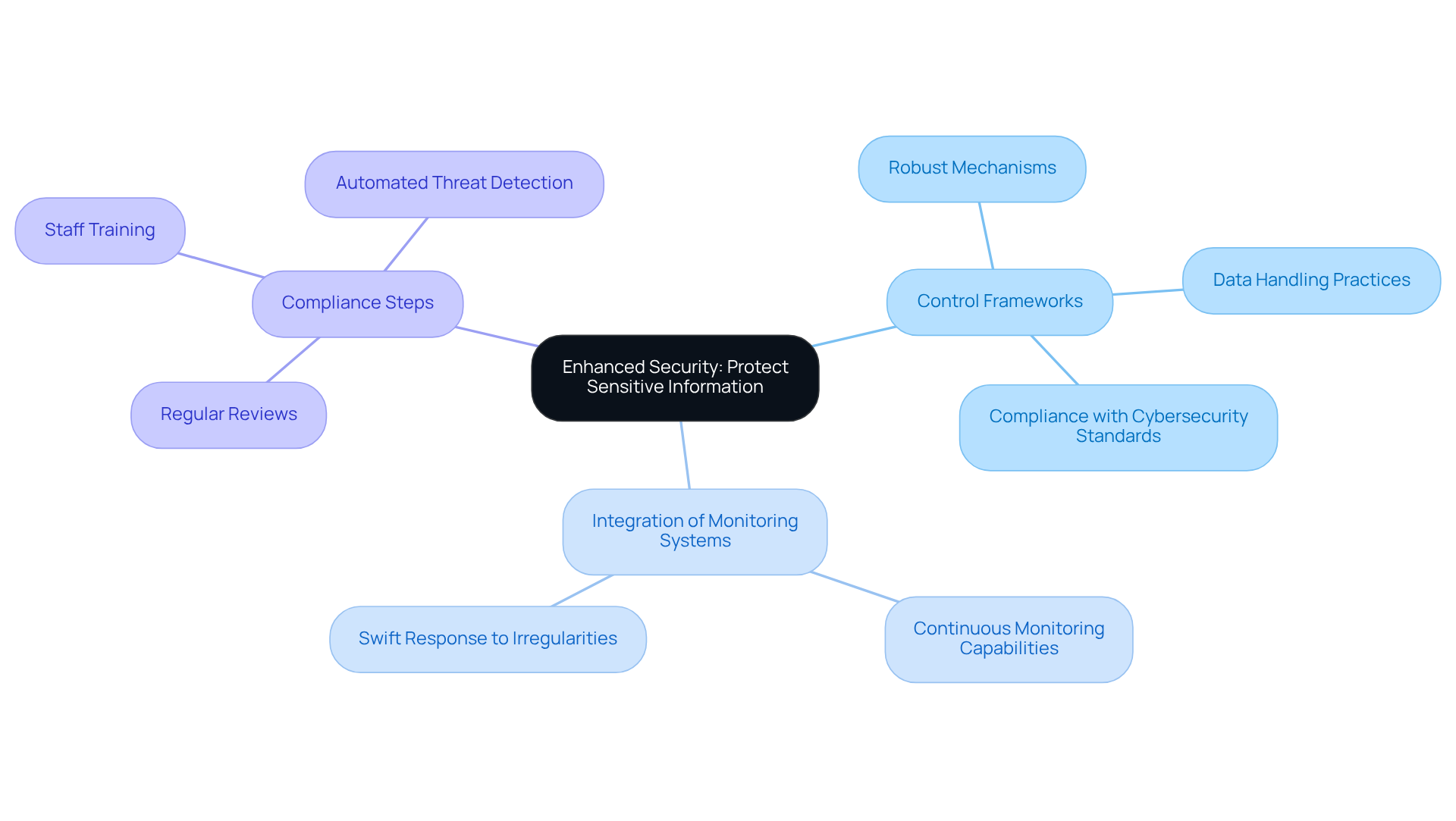
Automated Reporting: Simplify Compliance Documentation
Automated reporting tools significantly enhance the documentation process for defense contractors. They ensure that all compliance-related activities are accurately recorded and readily accessible. This simplification not only saves valuable time but also reduces the risk of errors—an essential factor for demonstrating adherence during audits and assessments.
Organizations adopting automated reporting solutions experience a remarkable 90% improvement in financial reporting precision. This directly contributes to increased audit success rates. Furthermore, these tools align with critical practices for policy maintenance in CMMC adherence, such as review frequency and version control.
To execute automated reporting efficiently, contractors should:
- Establish clear instructions for data entry.
- Conduct regular assessments of adherence documentation.
- Ensure all team members are trained on the process.
Have you considered how automation can streamline your operations? One financial institution noted that automation can cut approval times from several days to less than 24 hours, showcasing the efficiency gains achievable.
By utilizing these technologies, contractors can navigate regulatory challenges with greater assurance and efficiency. This guarantees a strong pathway for achieving DoD cybersecurity compliance. Are you ready to embrace these advancements and enhance your compliance efforts?
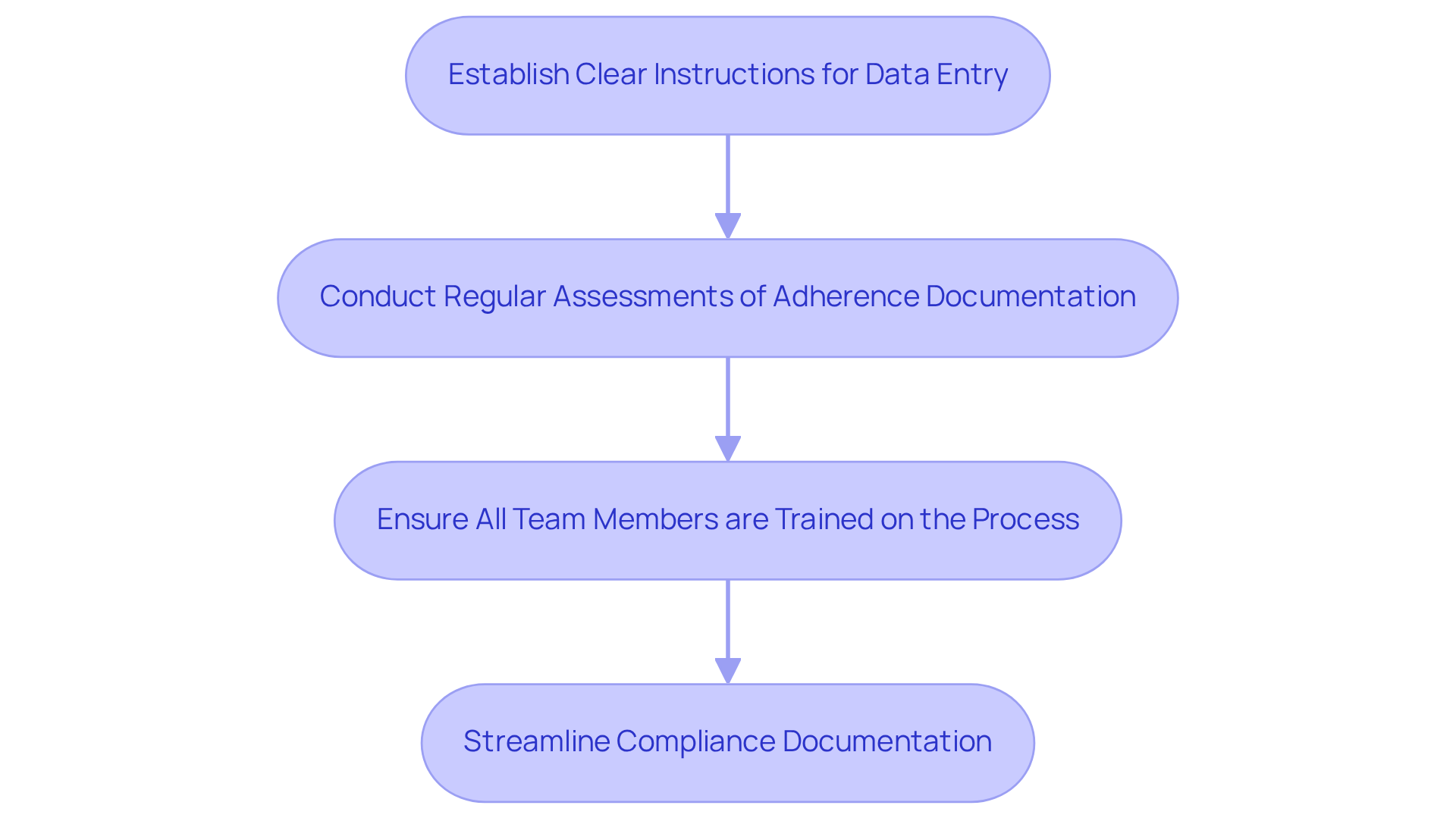
Scalability: Adapt to Changing Project Needs
Control and monitoring systems are essential for contractors, as they are designed to be scalable and adaptable to the changing requirements of projects. This adaptability not only ensures compliance with evolving regulatory measures but also aligns seamlessly with industry standards. By leveraging practical approaches and tapping into peer knowledge, contractors can confidently navigate the complexities of regulatory requirements.
But how can this flexibility benefit your projects? It meets urgent demands while establishing a robust control and monitoring system for ongoing oversight and maintenance practices. This is essential for upholding regulations and securing contracts.
To enhance your compliance journey, refer to the user manual. It offers a comprehensive roadmap to achieving CMMC standards, guiding you step-by-step towards successful adherence. Don't miss out on these valuable resources that can elevate your operations and ensure you stay ahead in the industry.
System Integration: Ensure Seamless Operation
The successful incorporation of a control and monitoring system is crucial for ensuring seamless operations across various departments within defense contracting. This integration not only enhances efficiency but also guarantees that regulatory measures are consistently implemented throughout the organization. By minimizing the risk of oversight and non-compliance, integrated solutions foster a uniform approach to regulatory adherence using a control and monitoring system.
Consider this: how can interconnected frameworks simplify procedures while fortifying your overall cybersecurity stance? Improved adherence through these frameworks aligns with the stringent standards set by the Department of Defense, ultimately strengthening your control and monitoring system for compliance posture.
Incorporating these frameworks is not just a strategic action; it’s a necessary step for defense contractors to confidently navigate the complexities of regulations with an effective control and monitoring system. By embracing these solutions, organizations can manage compliance with assurance, ensuring that they remain ahead in a rapidly evolving landscape.
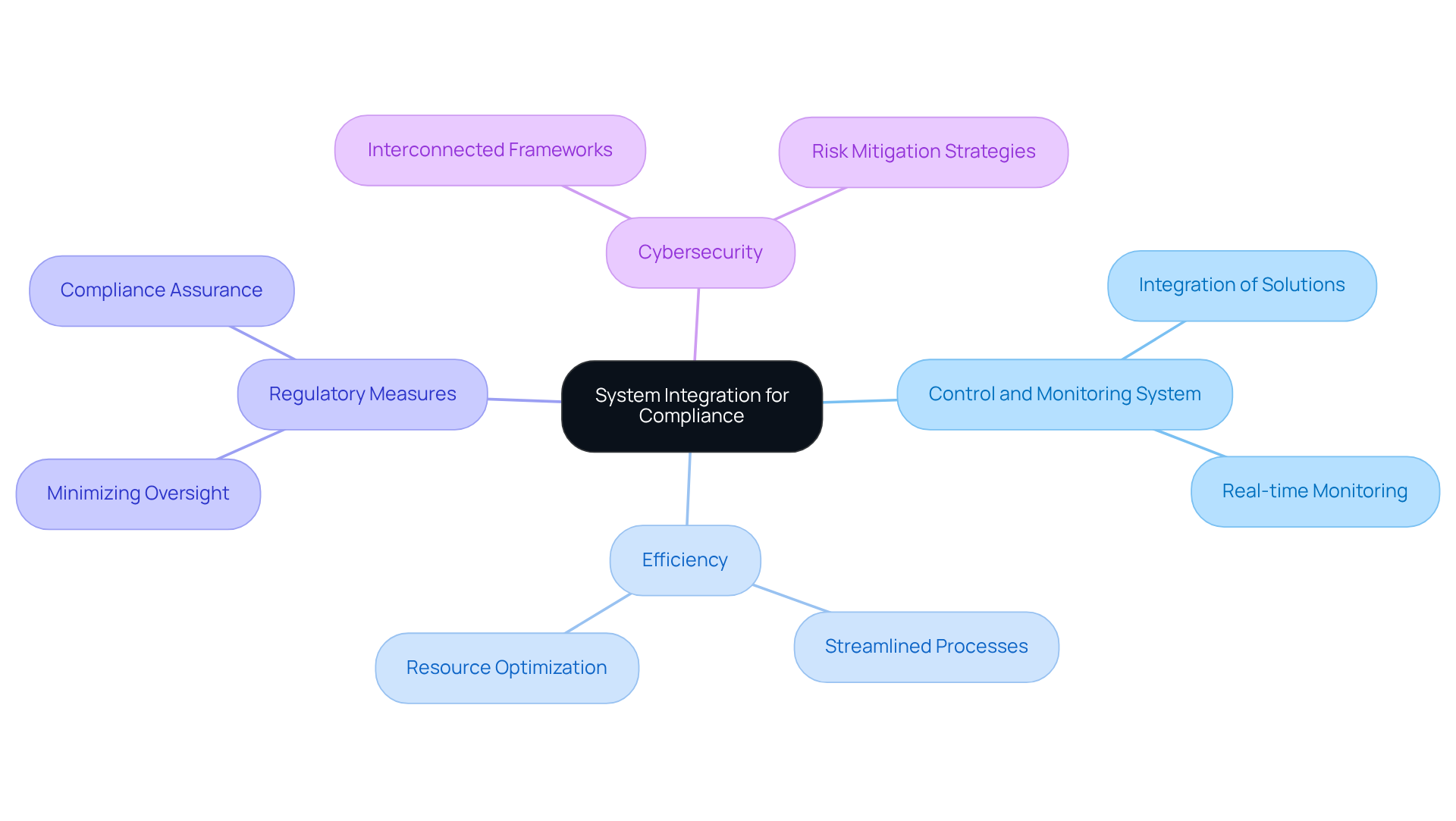
User-Friendly Interfaces: Facilitate Training and Adoption
Management and observation frameworks with intuitive interfaces significantly enhance training and acceptance of regulatory procedures among employees. When staff can navigate these frameworks effortlessly, their engagement with regulatory protocols improves, leading to stronger adherence to CMMC standards. As Frank Chimero aptly noted, "People overlook design that disregards individuals," highlighting the necessity of prioritizing user experience in design.
Moreover, accessible design not only streamlines training but also fosters a culture of compliance, enabling defense contractors to meet stringent regulatory requirements more effectively. By focusing on user-centered design and integrating practical approaches alongside peer perspectives, organizations can ensure their staff is well-equipped to handle regulatory frameworks.
This strategy aligns with the ultimate guide to achieving CMMC standards and supports essential self-evaluation for navigating Level 1 and Level 2 requirements. The result? Enhanced adherence rates and improved outcomes for your organization. Are you ready to elevate your compliance efforts?
Cost-Effectiveness: Manage Budgets While Achieving Compliance
For contractors in the security sector, investing in a control and monitoring system is a strategic move. This investment significantly enhances cost-effectiveness by streamlining operations and mitigating compliance-related penalties. Efficient budget management is essential; organizations that align their financial strategies with regulatory goals can improve their overall financial well-being and preparedness for defense contracts.
For instance, companies that adopt robust governance frameworks often see a reduction in operational inefficiencies, leading to substantial savings. Did you know that, according to E&Y, regulatory expenses can represent 11-25% of operational budgets for 44% of companies worldwide? This statistic highlights the necessity for efficient resource allocation.
As Jiaqi Zhou states, "Cost control starts with the budgeting process and involves identifying and reducing business expenses to increase profits." By implementing a control and monitoring system, organizations not only ensure adherence to CMMC standards but also position themselves to avoid costly penalties that can strain their budgets. This proactive approach to compliance management fosters a culture of accountability and transparency.
Ultimately, enhancing the organization's reputation and operational resilience is crucial. By prioritizing compliance and investing in the right systems, contractors can navigate the complexities of the security sector with confidence.

Conclusion
Implementing control and monitoring systems is crucial for defense contractors looking to boost operational efficiency, ensure compliance, and safeguard sensitive information. These systems offer a structured approach to navigating the complexities of regulatory requirements, particularly the stringent standards set by the Department of Defense. By leveraging these tools, organizations can streamline their compliance processes and position themselves for long-term success in an increasingly competitive landscape.
Several key benefits stand out:
- Real-time monitoring enhances operational efficiency
- Predictive maintenance minimizes downtime
- Data analytics supports informed decision-making
- Enhanced security measures
- Automated reporting for simplified compliance documentation
- Scalability of systems to adapt to evolving project needs
Each of these elements contributes to a robust framework that empowers defense contractors to navigate regulatory challenges while optimizing their operations.
Ultimately, embracing control and monitoring systems transcends mere compliance; it signifies a strategic investment in the future of defense contracting. As the industry evolves, organizations must prioritize these systems to protect their operations, bolster their cybersecurity posture, and maintain a competitive edge. By taking decisive action now, defense contractors can not only meet compliance requirements but also drive innovation and excellence within their organizations.
Frequently Asked Questions
What is the CMMC Info Hub?
The CMMC Info Hub is a centralized resource designed to help military contractors understand and navigate the complexities of CMMC regulations, providing practical strategies and insights for compliance.
How does the CMMC Info Hub assist defense contractors?
It offers organized guidance, comprehensive roadmaps, and actionable strategies, enhancing understanding and improving adherence rates to the CMMC standards set by the Department of Defense.
What benefits do organizations gain from using the CMMC Info Hub?
Organizations can streamline their compliance processes, gain clarity on requirements, and position themselves for success in securing government contracts while maintaining strong cybersecurity practices.
What is the importance of real-time monitoring for defense contractors?
Real-time monitoring allows defense contractors to continuously track operations, identify inefficiencies, and ensure adherence to CMMC standards, thereby enhancing productivity and risk management.
How does a control and monitoring system improve compliance?
It improves visibility into security and compliance, with users reporting enhanced insights from automated systems, which can also reduce compliance program costs and improve incident response times.
What role does predictive maintenance play in operational efficiency?
Predictive maintenance, supported by a control and monitoring system, analyzes equipment performance data to forecast failures, allowing contractors to schedule maintenance proactively and reduce downtime.
How do ongoing monitoring practices contribute to CMMC compliance?
Ongoing monitoring practices such as regular vulnerability scanning, prompt patch management, and continuous incident monitoring are essential for ensuring compliance with CMMC standards.
Why is minimizing downtime important for defense contractors?
Reducing downtime not only saves costs but also extends the lifespan of essential equipment, positioning organizations as leaders in compliance and operational excellence.




